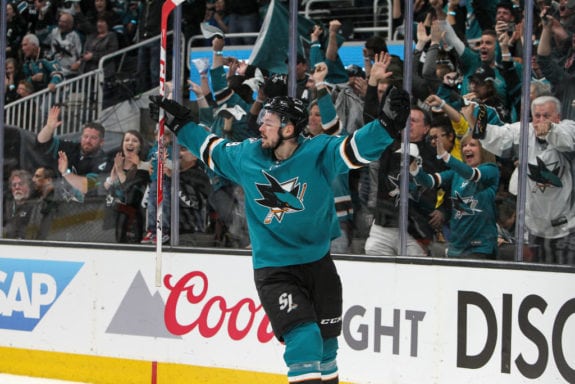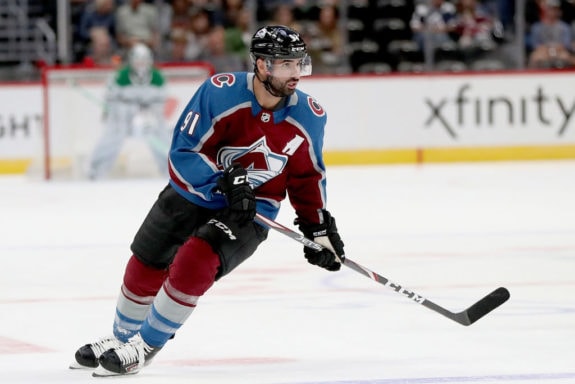Even though the San Jose Sharks are on track for a 19-point improvement over last season’s 82-game pace (90 vs. 71), their place in the Western Conference standings is a mirage. Despite occupying the second of two wild card spots, San Jose sits ninth in points percentage (.550), slowly falling further behind in the playoff race despite their marked improvements on the year. As a result, general manager Doug Wilson could test the waters on a handful of tantalizing assets with an eye towards a brighter future that’s already been set in motion.
Now, Wilson should hold off on initiating a fire sale until the teams in pursuit capitalize on their games on hand, but to not gauge the market for his most valuable assets is a flouting of his managerial duty. Of the many possible suitors, the Colorado Avalanche could stand to benefit considerably from acquiring the versatile Tomas Hertl, solving several of the team’s lingering issues. Let’s dig in.
Offense Is the Best Defense for the Avalanche
Adding Hertl – a significant offensive threat – appears counterintuitive for the Avalanche at first glance. Through nearly half of the season, Colorado is the NHL’s premier attacking group in scoring 4.27 goals per-60-minutes, 0.25 more goals per-60 than the second-place Florida Panthers. Although the Avalanche sit third in the NHL in points percentage (.736), they have yet to hit top gear. They rank 21st in goals-against per-60 (3.15), and their penalty kill (28th at 74.1%) remains a notable weakness.
Related: 3 Avalanche Trade Targets After Byram Injury
Still, the Avalanche succeed by committing to a discernible team identity, one built with an emphasis on speed and skill. As the Tampa Bay Lightning have shown in their successive Stanley Cup conquests, championships can be won on the back of a formidable offense. Rather than take away from what makes them special, Colorado could do well in doubling down on their strengths.
As far as feasible trade targets go, Hertl is as reliable an offensive contributor as they come, never dropping below a 60-point pace since the 2018-19 season. He has scored 20 goals in a single season four times, and his 35 points in 40 games in 2021-22 put him on pace for a 71-point campaign. Even with the Sharks in a transitional period, he can be counted on to pull his weight in the offensive zone.

In terms of his offensive contributions, Hertl profiles as an above-average shot generator (86th among forwards in shots per-60) and goal-scorer (41st in goals per-60). Nazem Kadri and Nathan MacKinnon rank among the NHL’s top playmakers as both produce greater than 14 shot-assists per-60 (final pass before a shot), so having Hertl as an additional sniper plays well off of their strengths.
Hertl’s Versatility Solves Avalanche’s Weaknesses
Although I’m playing up Hertl’s offensive prowess, the Sharks center is a versatile two-way threat, featuring regularly on San Jose’s penalty kill over his NHL tenure. As the Avalanche has struggled mightily in this department this season, procuring Hertl from the Sharks kills two birds with one proverbial stone.
On top of his scoring duties, Hertl has been a fixture on the Sharks’ shorthanded units for several seasons. He’s averaged a minimum of 1:13 per game on the penalty kill since the 2016-17 season, and San Jose’s kill efficiency has never dipped below 80% in that time, twice finishing either first or second in league ranking.
Related: 3 Avalanche Trade Targets To Fix Penalty Kill
Additionally, Hertl can consistently turn the numerical disadvantage of being shorthanded into scoring opportunities for his club. The native of the Czech Republic ranks 16th in goals per 60 and 36th in points per 60 among forwards to have played at least 200 minutes on the penalty kill since the 2019-20 season. He’s not the primary option on the penalty kill (88th in average time-on-ice among forwards), but he’s dependable enough that coaches feel comfortable utilizing his skills.
An underrated factor in Colorado’s inability to regularly kill penalties is their weakness in the faceoff dot, only winning 47.2% of all draws this season. Luckily, Hertl is an adept faceoff man, taking the most draws on the Sharks’ roster this season and winning 53.4% of his assignments. Hertl’s 668 draws on the year would lead Colorado, and he’d become their second-most successful skater in the faceoff dot behind Gabriel Landeskog (55.3%). For his career, Hertl has won 52.8% of his draws, bolstering his case as a potential solution for the Avalanche.
Hertl isn’t a black hole in possession either, his defensive responsibilities remain a priority despite his offensive duties. With the 28-year-old center on the ice, the Sharks control 50.6% of all unblocked shot attempts (FF%), 51.9% of scoring chances (SCF%), and 55.2% of high-danger chances (HDCF%). He’s not a defensive stalwart by any means, but he’s held his own on a retooling Sharks’ squad over the past two seasons.
Hertl Is Insurance for Potential Kadri Regression
Although Kadri’s surprising offensive outburst this season is a welcome shock for the Avalanche, it’s not a trend that the team can count on persisting indefinitely. Kadri’s career-high currently stands at 61 points in 82 games, set in the 2016-17 season as a member of the Toronto Maple Leafs. His points-per-game pace (P/G) of 1.48 in 2021-22 tracks for an 82-game total of 121 points, nearly double his career benchmark.

Further, the injury troubles which plagued the beginning of Colorado’s campaign elevated Kadri into more a prominent offensive role, and he benefitted from becoming a greater focal point of the team’s flammable power play. Once the lineup settles into a more consistent setup, his cushy gig – and prolific rate of production – is no longer guaranteed.
In addition, Kadri’s 5v5 on-ice shooting percentage (OiSH%) of 13.65% represents the second-highest mark of his career. This means that when he is on the ice, he and his linemates are converting at an above-average rate, suggesting that his scoring total owes a slice of gratitude to good fortune. He deserved some good luck after last season (his OiSH% was 7.49%, nearly half of this year’s mark), but to dismiss the greater context is an example of willful ignorance.
Related: The NHL’s 5 Biggest All-Star Game Snubs
However, adding Hertl as the second-line center presents two key benefits. First, Kadri is pushed down into a third-line role, allowing him to feast on the weaker competition while giving the Avalanche an unparalleled sequence of centers to trot out every night. Second, Hertl’s history of increased production in a more demanding role indicates that his presence can mitigate the negative impact of a potential Kadri regression. Kadri isn’t a 100-point player, and preparing for the inevitable offers Colorado greater potential for future success.
Is a Hertl Trade the Best Use of Colorado’s Assets?
As Hertl is sure to incite a fierce bidding war, the Avalanche could be called to muster up a formidable trade offer to beat out several other interested parties. They currently lack their first- and second-round picks for the 2022 Entry Draft but own their own picks for the opening rounds of the 2023 iteration. Given how goaltending is a more pressing priority for the Avalanche this season, they are likely to be forced to decide on how to most efficiently utilize their finite pool of assets. For that reason, they might find themselves out of the running if Hertl enters the deadline as the most attractive target, but that shouldn’t stop them from trying. Banners fly forever, after all.
Data courtesy of All Three Zones, Natural Stat Trick, and the NHL.
